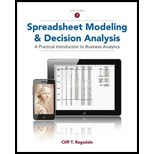
Spreadsheet Modeling and Decision Analysis: A Practical Introduction to Business Analytics
7th Edition
ISBN: 9781285418681
Author: Cliff Ragsdale
Publisher: Cengage Learning
expand_more
expand_more
format_list_bulleted
Concept explainers
Question
Chapter 1, Problem 16QP
Summary Introduction
To determine: The meaning of the terms’ description, prediction, and prescription.
Expert Solution & Answer
Want to see the full answer?
Check out a sample textbook solution
Students have asked these similar questions
In an age when going digital is an unavoidable business decision, understanding how digital entrepreneurship influences the formation and development of successful Multinational Enterprises (MNEs) has been a crucial topic in international business studies. While digital entrepreneurship has been seen as a challenge and disruption in some recent literature, is it possible that businesses may be able to find their opportunities during digitalization? Mainly, how can the internationalization process of business be consciously/actively or unconsciously/and passively motivated and reformed by the digitalization trend?
What are in your opinion the digital strategies and tools that can foster the development of the Industry 4.0 ?
Corporate Responsibility has been a 'buzz word' in the last few years. There is no doubt that each organization should exhibit corporate responsibility.
When did corporate responsibility gain impetus and why?
Which company(ies) can be given credit for leading the way for corporate responsibility?
Chapter 1 Solutions
Spreadsheet Modeling and Decision Analysis: A Practical Introduction to Business Analytics
Ch. 1 - Prob. 1QPCh. 1 - Prob. 2QPCh. 1 - Prob. 3QPCh. 1 - Prob. 4QPCh. 1 - What is the relationship between business...Ch. 1 - What kinds of spreadsheet applications would not...Ch. 1 - Prob. 7QPCh. 1 - Prob. 8QPCh. 1 - What is a dependent variable?Ch. 1 - What is an independent variable?
Ch. 1 - Can a model have more than one dependent variable?Ch. 1 - Can a decision problem have more than one...Ch. 1 - Prob. 13QPCh. 1 - Prob. 14QPCh. 1 - In what ways are descriptive models different from...Ch. 1 - Prob. 16QPCh. 1 - Prob. 17QPCh. 1 - Consider the spreadsheet model shown in Figure...Ch. 1 - Prob. 19QPCh. 1 - Prob. 20QPCh. 1 - Prob. 21QPCh. 1 - Prob. 22QPCh. 1 - Prob. 23QPCh. 1 - Prob. 24QPCh. 1 - Prob. 25QPCh. 1 - Prob. 26QPCh. 1 - Prob. 27QP
Knowledge Booster
Learn more about
Need a deep-dive on the concept behind this application? Look no further. Learn more about this topic, management and related others by exploring similar questions and additional content below.Similar questions
- Defining the scope of an information technology project is a challenging task due to the uncertainties in time, cost, technologies, quality, human resources, and so on. Address the following questions. How would techniques of project scope management ensure the project objectives can be achieved in an information technology project? Can any of the agile approaches be engaged in the project scope management for a better efficiency?arrow_forwardDirections: In Chapter 1 we introduce Project Management. Why is there a new or renewed interest in project management? 2. What is a project? What are its main attributes? What are some examples of different size projects? 3. What are project constraints? How do they affect the project management process? 4. What is the relationship between Projects, and operations? 5. What are some skills recommended for project managers? Why would these skills be important in the management of projects? 6. What is the PMI Talent Triangle and what role do they play in the project management field?arrow_forwardDo you think businesses ever mistakenly cling to outdated ideas of "acceptable" profit, even as their industry conditions shift?arrow_forward
- Question 2/60 Correction is always better than: Maintenance Containment Root cause identification Preventionarrow_forwardQuestion 47 / 60 Root cause is related to: The "x" on y=f(x) The "y" on y=f(x) The "=" on y=f(x) The "f" on y=f(x)arrow_forwardQuestion 58/60 Ishikawa is more applicable to projects related to lead time. This statement is: True Falsearrow_forward
- Question 49 / 60 Lean Six Sigma is focused on solving highly complex problems. This statement is: False Truearrow_forwardQuestion 60 / 60 Lean Six Sigma guarantees that all problems can be solved. This statement is: False Truearrow_forwardQuestion 23/60 Sigma Level is is used to evaluate how stable my process is. This statement is: True Falsearrow_forward
- Question 24/60 Lean Six Sigma is focused on problems that present low complexity. This statement is: False Truearrow_forwardQuestion 19/60 Control Charts are used to evaluate process stability. This statement is: False Truearrow_forwardQuestion 18/60 We must find the root cause in a Lean Six Sigma project. This statement is: False Truearrow_forward
arrow_back_ios
SEE MORE QUESTIONS
arrow_forward_ios
Recommended textbooks for you
- MarketingMarketingISBN:9780357033791Author:Pride, William MPublisher:South Western Educational Publishing
 Foundations of Business (MindTap Course List)MarketingISBN:9781337386920Author:William M. Pride, Robert J. Hughes, Jack R. KapoorPublisher:Cengage Learning
Foundations of Business (MindTap Course List)MarketingISBN:9781337386920Author:William M. Pride, Robert J. Hughes, Jack R. KapoorPublisher:Cengage Learning Foundations of Business - Standalone book (MindTa...MarketingISBN:9781285193946Author:William M. Pride, Robert J. Hughes, Jack R. KapoorPublisher:Cengage Learning
Foundations of Business - Standalone book (MindTa...MarketingISBN:9781285193946Author:William M. Pride, Robert J. Hughes, Jack R. KapoorPublisher:Cengage Learning

Marketing
Marketing
ISBN:9780357033791
Author:Pride, William M
Publisher:South Western Educational Publishing



Foundations of Business (MindTap Course List)
Marketing
ISBN:9781337386920
Author:William M. Pride, Robert J. Hughes, Jack R. Kapoor
Publisher:Cengage Learning

Foundations of Business - Standalone book (MindTa...
Marketing
ISBN:9781285193946
Author:William M. Pride, Robert J. Hughes, Jack R. Kapoor
Publisher:Cengage Learning
Introduction to Forecasting; Author: Ekeeda;https://www.youtube.com/watch?v=5eIbVXrJL7k;License: Standard YouTube License, CC-BY